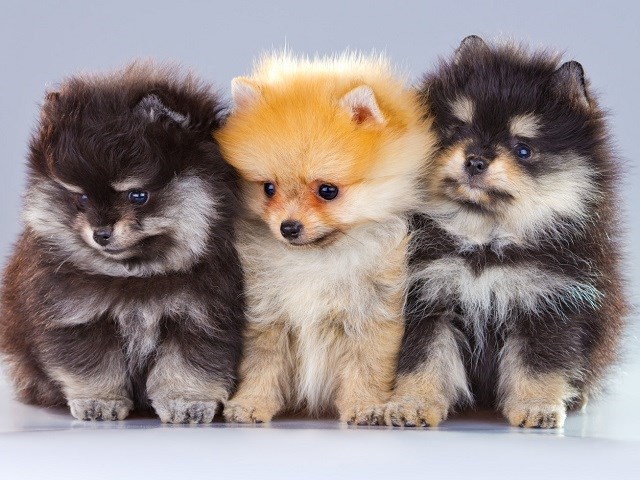Pomeranian Breed Information
At a Glance
| Male Height | 6 - 11 inches |
| Female Height | 5 - 10 inches |
| Male Weight | 5 - 8 pounds |
| Female Weight | 3 - 7 pounds |
| Size | Tiny |
| Colors | white, black, brown, red, orange, cream, blue, sable, black and tan, brown and tan, spotted and brindle |
| Hypoallergenic | No |
| Personality | Affectionate, Intelligent, Outgoing, Playful, |
| Lifespan | 12 - 16 years |
Introduction
The Pomeranian (also known as a Pom or Pom Pom) is closely related to the German Spitz. The average owner will tell you that this toy dog is a marvelous companion and makes for a great lap dog, This fluffy little fur ball is a great addition to any good home.
History
The Pomeranian is descended from larger working dogs from the Arctic. The name is derived from a region that spans an area that covers parts of Poland and Germany on the Baltic Sea. Although the breed originated in Germany, the modern dog was developed in the UK during the 18th and 19th century.
Temperament
The Pomeranian owner will typically find his dog to be affectionate and playful. The breed's even-keeled temper and friendly nature endear it to many. For a toy breed it is fairly independent and unlike some other breeds in this class can be left alone for short periods of time At time it will need a firm, gentle hand.
Coat
Pomeranians have a thick, double coat, thee outer coat is long, straight, and harsh in texture while the undercoat is soft, thick and short. They comes in a huge array of colors: white, black, brown, red, orange, cream, blue, sable, black and tan, brown and tan, spotted, brindle, plus combinations of those colors. Merle is a more recent addition to the line - is a combination of a solid base color with a lighter mottled bluish grey color.
Do Poms do well in Apartments?
They are small enough for most apartment and usually fall with the weight guidelines, and can be left alone for short periods if properly trained. If exercised properly and potty trained Pomeranians will thrive in an apartment. If keeping them in an apartment it is important that they have plenty of toys to keep them occupied.
Barking
They can be defensive of their territory and thus may bark when they unknown noises. Doorbells seem to get them particularly excited. They may not be large enough to be a guard dog but make excellent watchdogs.
Do Poms Get Along With Children & Other Pets?
Poms do not always do well with children. They usually fond a strong bond with their owner, but often see small children and other animals as competitors and can be protective of their food and toys. Although not dangerous they can nip. If your looking for companionship it is a great dog, but not necessary the best choice foe a family dog unless you are willing to put in a lot of time training it.
Exercising a Pomeranian
To keep these dogs healthy they should be walked on a daily basis. They enjoy running, so some yard time every week will be welcome. As they are quite intelligent, some owners choose to enroll their dogs in agility training classes which can provide a good deal of the exercise they need.
How to Groom a Pomeranian
They need to be regularly brushed to keep their top coats shiny and healthy, and prevent their undercoats from matting. Most Poms also benefit from a good trimming session every couple of months or so.
Pom and Shedding
Poms shed year round, but especially on the Spring and fall when they shed their undercoats.
Pom Health Problems?
Pomeranians are among the healthiest of they toy breeds and do not suffer from as many hereditary diseases as some other small dogs and usually live longer lives. Possible afflictions are: luxating patella, elbow dysplasia and tracheal collapse. They can also suffer from dental problems- if their teeth are not taken care of properly.
Are Poms Intelligent?
Pomeranians are intelligent dogs, respond well to training, and can be very successful in getting what they want from their owners. They can be taught verbal commands fairly quickly and will respond to a first time command about 50% of the time.
Pomeranian
Pomeranians need to be socialized at an early age. They are intelligent and enjoy attention, so training is fairly easy, especially if you give them small treats for successful behaviour. Many owners enroll them in agility classes and teach them to run obstacle courses.
